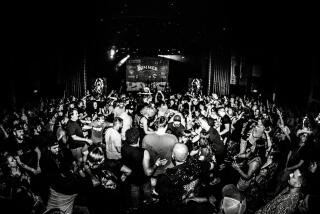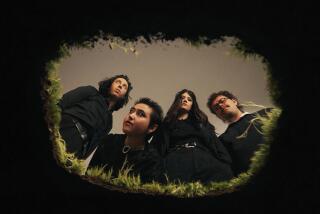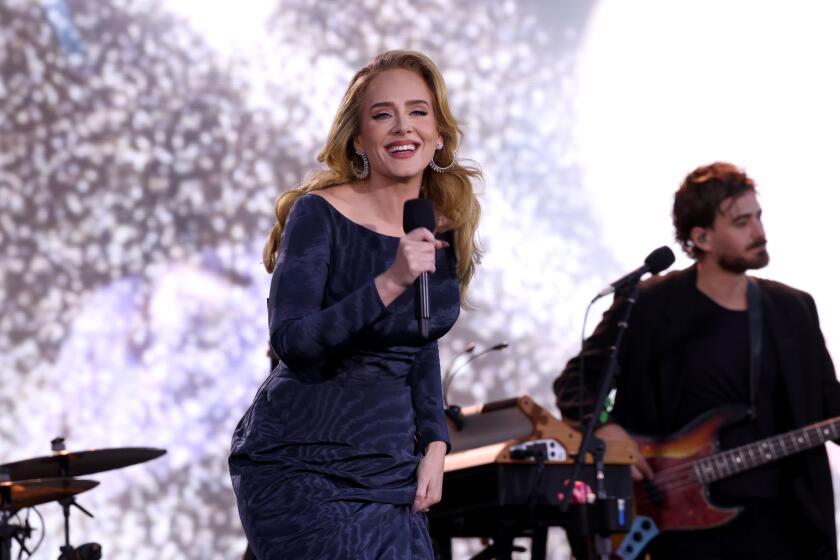Pop Music Review : Lollapalooza ’94 Finds Its Balance at Finale
Inside Cal State Dominguez Hills on Sunday, fans pogoed happily in front of Lollapalooza ‘94’s second stage, cheering to the pop songs of Japan’s Shonen Knife, while yards away at the main stage, giant mosh pits surged to the aggressive chants of L7.
In between the two stages, carnival rides spun, poets pontificated, interactive computers interacted and dozens of booths filled with political paraphernalia, food and retail booths bustled. It was virtually an eclectic rock and rap carnival.
Yes, Lollapalooza mastermind Perry Farrell’s dream has finally come true.
The Porno for Pyros frontman has always referred to the summer tour--now in its fourth year--as a traveling show with a carnival appeal, but until this year, his dream only took a vague or lopsided shape.
In the past, either the main stage lineup far outweighed the smaller second stage fare, or the non-musical events were too sparse, or both.
But as the two-month 1994 edition wound up last weekend, Lollapalooza seems to have finally hit a pinnacle where all elements balanced.
The multitude of bands (mostly good) on the two stages and non-musical events (mostly fun) gave more than 30,000 fans so many things to choose from on Sunday that it was overwhelming--just as any good carnival should be.
Quite naturally, the reviews from the early shows in the two-month tour stressed acts on the main stage--which meant most of the media attention has been on headliners Smashing Pumpkins and the Beastie Boys, both of which turned in strong sets Sunday.
This emphasis on the main stage was reinforced when the tour opened at the Sam Boyd Silver Bowl in Las Vegas because the second stage was relegated to a small corner of the facility, and the non-musical elements were limited.
At Cal State Dominguez Hills, where the tour was scheduled to end Monday, the second stage was given far more prominence and the non-musical aspects were greatly expanded. The result was that these elements offered strong, constant competition to the main stage lineup.
In one of the best sets of the day, Cypress Hill packed the second stage, booming laid-back hip-hop tunes and serving up more odes to the almighty weed, while the audience jumped up and down en masse.
Lesser known bands like England’s Stereolab, which plays a mutation of ‘60s cocktail music, and local jazzy hip-hopsters Pharcyde also held large audiences, even though they competed with the likes of the Breeders and Green Day, whose sets ran simultaneously on the main stage.
Stereolab’s intricacies may not have come across quite as well outdoors as in clubs, but the surreal-sounding band compensated by playing more straightforward versions of songs.
Pharcyde hypnotized the audience into a blissful groove with its hip-hop meltdowns, while Shonen Knife delivered irresistibly pure pop. But not everything on the second stage was as glorious. Shudder to Think’s set was bogged down in melodramatic vocals and unfocused tunes, while the Boo Radleys came across as simply sappy.
When the second stage shut down just before sunset, all attention was again focused on the main stage, where the Beastie Boys had already began churning out its hyperactive blend of hip-hop and hard-core rock with bouncy stage moves and high-strung raps.
Smashing Pumpkins closed the show triumphantly with an hour of bittersweet sounds--from waves of reeling guitar to lulls of contemplative simplicity--that are so smartly crafted yet spontaneous and soulful, reflecting the whole tone of Lollapalooza ’94.
More to Read
The biggest entertainment stories
Get our big stories about Hollywood, film, television, music, arts, culture and more right in your inbox as soon as they publish.
You may occasionally receive promotional content from the Los Angeles Times.











